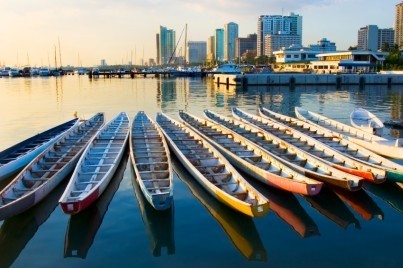
Located on the west coast of the main island in the Philippines (Luzon), Manila is a bustling and lively capital city that is one of the most populated in the world. With over three decades of Spanish colonization, Manila has some distinct architecture and heritage including churches, forts and other colonial buildings.
The city was almost all but demolished during WWII and has never fully recovered. There is no definable center of Manila, but just a mixture of districts and towns. All together there are 16 districts of Manila, which all have their own unique identification and atmosphere.
The Pasig River runs through the center of the city and inland and there are eight districts on either side. Binondo is one of the main areas of Manila and home to Chinatown and the Chinese immigrant community. Ermita and Malate districts are both full of nightlife and modern amenities and consequently attract foreign tourists.
Throughout the exciting city, tourists will find history and culture that is unique to the Philippines. Just walking through the neighborhoods is an attraction in itself with so much to see and experience.
On the south bank of the river is this Spanish built walled quarter, which is full of colonial charm. Attractions such as Fort Santiago and the many churches that dot the district draw tourists in their thousands but most stay outside the district, which has few hotels.
Binondo is the main business center of Manila and also the location of Chinatown. Chinese immigrants largely populate the district and there is a host of Chinese influenced restaurants, shops and entertainment venues.
Located in the west of Manila, San Miguel is a middle class residential area that has a host shops and restaurants available. There are numerous historical attractions and tourist sights in the district.
Founded in the 16th century, Ermita is a popular area of Manila offering cultural attractions as well as entertainment venues and shopping centers. Ermita is also home to the red light district of the city, which has been largely cleaned up in the past decade.
Situated along the Pasig River in the north of Manila, Santa Cruz is a Spanish colonial area with numerous attractions including churches dating back to the 1600s. Santa Cruz also has an array of restaurants, shops and bars.
Paco is positioned south of the Pasig River and is a popular tourist district with various attractions including the Gates of Paco, Paco Park and numerous churches and temples. There is a large Japanese community in Paco and countless Japanese restaurants, bars and eateries.
One of the oldest parts of the city, Tondo existed before colonial times. The large district is the poorest area of Manila and the most underdeveloped, being home to many of the city's slums. Visitors can find a number of tourist attractions in Tondo however, including Smokey Mountain and Plaza Morga.
Found in the south of Manila, Malate was originally a fishing village during Spanish colonial times. There are countless hotels, restaurants and shops in Malate, making it popular with tourists. The nightlife scene in Malate is lively, with a plethora of bars, clubs and discotheques available.
The Port of Manila is the largest seaport in the country, with both shipping and passenger ferries. The area dates back to the 9th century, before the Spanish rule of the Philippines. Although the area is mainly industrial and commercial there are numerous restaurants and hotels located near the ferry port catering to tourists.